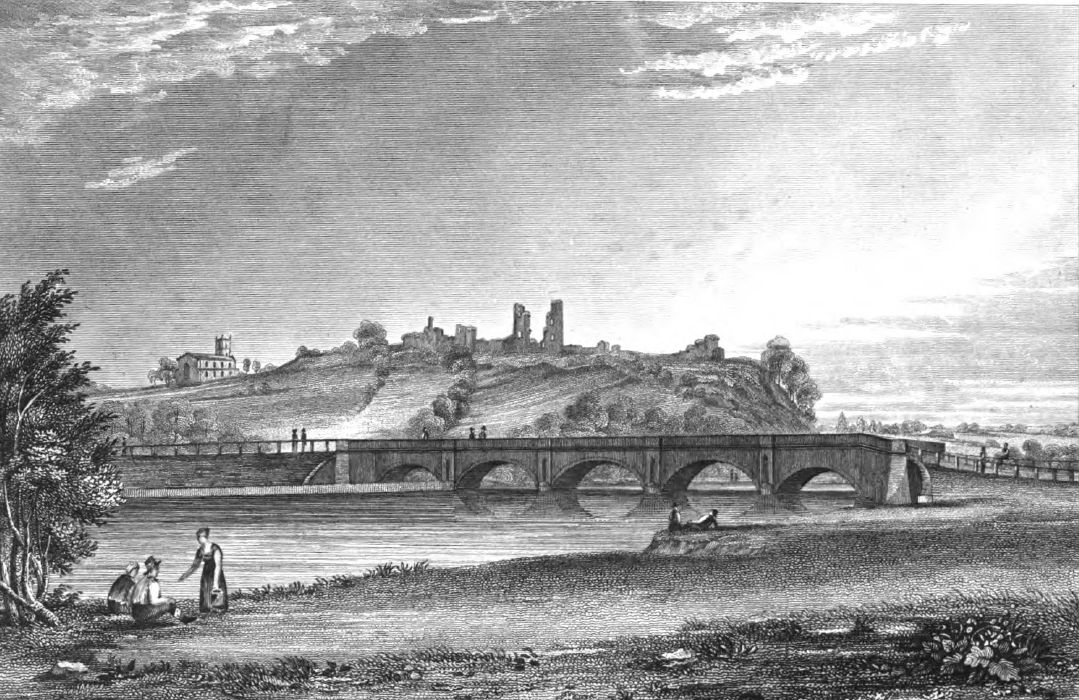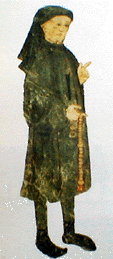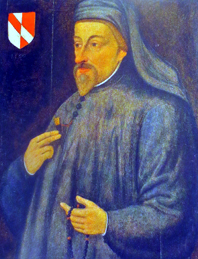 |
| One of the strongholds of John of Gaunt - Tutbury Castle with the bridge over the River Dove and the priory church, about 1832 |
 Chaucer was born about 1340 in London.
His father was John Chaucer, citizen & vintner of London, his mother
Agnes. Geoffrey's grandfather was RobertChaucerofIpswich & London
who married a widow Mari Heyroun with a son Thomas Heyroun.#
His grandfather may be John le Chaucer of London mentioned by the London
annalist in 1302.5 John Chaucer's house stood in upper Thames Street beside Wallbook, an open
sewer in those times, where today a tunnelled drain is crossed by a railway
from Cannon Street railway station. John Chaucer was in attendance on
Edward III in 1338. This led to Geoffrey's employment with the king's
court as a page in the Duke Lionel and Princess Elizabeth's household [Duke
of Clarence - Edward was the first king to give dukedoms to his family which
was a Normandy-French tradition] In 1357, accounts show articles were
purchased for Geoffrey when he was about seventeen years of age. In 1359
at the age of about nineteen, he was present at Queen Isabella's funeral
as a page in Lionel's household. Isabella's body was interred at Newgate
priory with the heart of her husband Edward II.1 Isabella's heart
however was buried at Castle Rising, Norfolk, perhaps a sign that Edward the
II could have her body but never her heart. In the same year he joined Edward
III's army when France was invaded, where he was taken prisoner. In May
1360 The Peace of Bretigny was declared near Chartres. Chaucer was given
his liberty in March when Edward paid £16 towards his ransom.
# Thomas Heyroun married the heiress Maud Berghersh.
Chaucer was born about 1340 in London.
His father was John Chaucer, citizen & vintner of London, his mother
Agnes. Geoffrey's grandfather was RobertChaucerofIpswich & London
who married a widow Mari Heyroun with a son Thomas Heyroun.#
His grandfather may be John le Chaucer of London mentioned by the London
annalist in 1302.5 John Chaucer's house stood in upper Thames Street beside Wallbook, an open
sewer in those times, where today a tunnelled drain is crossed by a railway
from Cannon Street railway station. John Chaucer was in attendance on
Edward III in 1338. This led to Geoffrey's employment with the king's
court as a page in the Duke Lionel and Princess Elizabeth's household [Duke
of Clarence - Edward was the first king to give dukedoms to his family which
was a Normandy-French tradition] In 1357, accounts show articles were
purchased for Geoffrey when he was about seventeen years of age. In 1359
at the age of about nineteen, he was present at Queen Isabella's funeral
as a page in Lionel's household. Isabella's body was interred at Newgate
priory with the heart of her husband Edward II.1 Isabella's heart
however was buried at Castle Rising, Norfolk, perhaps a sign that Edward the
II could have her body but never her heart. In the same year he joined Edward
III's army when France was invaded, where he was taken prisoner. In May
1360 The Peace of Bretigny was declared near Chartres. Chaucer was given
his liberty in March when Edward paid £16 towards his ransom.
# Thomas Heyroun married the heiress Maud Berghersh.
"Contributions for Ransoms Made by the King,
12 January to 7 July 1360"2
|
In 1367 Chaucer was given a life pension for being a valet of the king's household but Duke Lionel died in 1368 and Chaucer then transferred his services to John of Gaunt, the Duke of Lancaster.
 |
| One of the strongholds of John of Gaunt - Tutbury Castle with the bridge over the River Dove and the priory church, about 1832 |
1369 was the year of the third Great Pestilence. John of Gaunt's wife,
Blanche of Lancaster died at the age of 29, this was commemorated in "The
Death of Blaunche the Duchess". Blanche 'Plantagenet' was the granddaughter
of the third earl of Lancaster and brought the vast wealth of the Lancastrian
line to Gaunt. Yet despite marriages of convenience being the way to aquire
heiresses wealth, Gaunt seems to have truly mourned at the loss of his first
wife, for he was buried with her in an elaborate tomb in St. Paul's Cathedral,
but which was destroyed by fire in 1666.
1370-3 December 1372 Geoffrey travelled to Genoa, Pisa, and Florence on
the king's service for 11 months
1370-1386 Chaucer had returned to London. These visits to Italy influenced
his writings.
1374 April 23rd St. Georges Day- Chaucer was granted a pitcher
of wine daily to be received from the king's butler.
1374 10th May Chaucer leased a house at Aldgate but released it to a
friend in October 1386.
 1374, June 8th Chaucer was made comptroller of the Customs and Subsidy
of Wools, Skins and Leather for the Port of London. On the 13th
1374, June 8th Chaucer was made comptroller of the Customs and Subsidy
of Wools, Skins and Leather for the Port of London. On the 13th June 1374 Chaucer was given a life pension of £10 from John of
Gaunt, the Duke of Lancaster and his mother Queen Philippa.
Chaucers wife, also named Philippa, was one of the ladies in Queen
Philippa's chamber on 12th September 1366 and is also known to have been
a damsel to Constanza of Castile, John of Gaunt's Spanish wife. Constanza
was the sister to Isabella who married Edmund de Langley, John of Gaunt's
younger brother. Supposedly one of Chaucer's poems is dedicated to Constanza.
Philippa Chaucer was the sister to [K]Catherine Swynford [nee Roet] the
third wife of John of Gaunt, the surname Roet is a Flemish one. Katherine
Swynford was the governess of Constanza's and John's children and later John's
wife.Edward III died on 21st June 1377 from then on Geoffrey was employed
in the court of both Richard II and Henry IV. By 1386 Chaucer had been elected
a knight for the shire of Kent in the Parliament held at Westminster. Geoffrey
Chaucer's son, Thomas Chaucer, was also elected a knight. Thomas like his
father became a well known courtier and also a Parliamentarian, he may have
fought at the Battle of Agincourt. A brass in memory of Thomas and
his wife, Matilda, of 1436 appears in the church at Ewline, Oxon. Chaucer's
grand-daughter, Alice, married the Duke of Suffolk, she died in 1475.
June 1374 Chaucer was given a life pension of £10 from John of
Gaunt, the Duke of Lancaster and his mother Queen Philippa.
Chaucers wife, also named Philippa, was one of the ladies in Queen
Philippa's chamber on 12th September 1366 and is also known to have been
a damsel to Constanza of Castile, John of Gaunt's Spanish wife. Constanza
was the sister to Isabella who married Edmund de Langley, John of Gaunt's
younger brother. Supposedly one of Chaucer's poems is dedicated to Constanza.
Philippa Chaucer was the sister to [K]Catherine Swynford [nee Roet] the
third wife of John of Gaunt, the surname Roet is a Flemish one. Katherine
Swynford was the governess of Constanza's and John's children and later John's
wife.Edward III died on 21st June 1377 from then on Geoffrey was employed
in the court of both Richard II and Henry IV. By 1386 Chaucer had been elected
a knight for the shire of Kent in the Parliament held at Westminster. Geoffrey
Chaucer's son, Thomas Chaucer, was also elected a knight. Thomas like his
father became a well known courtier and also a Parliamentarian, he may have
fought at the Battle of Agincourt. A brass in memory of Thomas and
his wife, Matilda, of 1436 appears in the church at Ewline, Oxon. Chaucer's
grand-daughter, Alice, married the Duke of Suffolk, she died in 1475.
Geoffrey was employed on secret business by King Richard II in 1398 being
issued with a letter of his protection. In October of the same year Geoffrey
was given by King Richard an annual grant of £20 and wine from the
Port of London, these grants were repeated under King Edward IV.3
Certainly Richard II's court was one of the most refined in Europe, more
like a French court, opulent and decadent with 10,000 persons engaged, 3000
being kitchen staff or 'servitors' and 300 chamberlains and ladies of the
court. A fitting goldfish bowl for Chaucer to garner his observations
about all levels of society.
Edward III [Previous]
William de Montague
John of Gaunt
The Knightes
Tale [a film review]
Sources/References:
1. Weir, Alison. Queen Isabella, 2007, pp. 385-386.
2. Crow, Martin, M., & Olson, Clre, C., Chaucer Life-Records, Oxford,
1966.
3. Holland, Bernard. The Hollands of Lancashire. London, 1917. pp.
86-87.
4. Skeat, W. W. ed, The Poems of Geoffrey Chaucer, O.U.P. 1915.
5. Stubbs, William. Annales Londonieses, 1882, pp. 127-128. [Original research and speculation]
A
Canterbury Tale A cult 1944 film loosely based upon the variety of
pilgrims in Chaucer's Canterbury Tales. An excellent display of the
Kent countryside and Canterbury in 1944 after the bombing of 1940 the
final scenes displaying barrage balloons